THE NEW CHAPEL

.jpg) The Healds were big folk at Waterside more than a century back, and they secured the land on which the present Chapel and Preacher's house were to be built, from Randle Taylor, the owner of the estate right away to Low Leighton, who had lived close to where the Chapel now is, but who had removed to Wormhill, near Tideswell, and thus it was that the land was leased by Mr. James Heald. It was part of the " Great Mill Field," and was let on a perpetual rent of £10 10s. 8d. per year. But this was only the plot on which the Chapel and house stand, in fact Randle Taylor's house stood close by, and his garden was afterwards acquired for burial-ground purposes. The chapel and house having been built, the property was, on the 6th of August, 1810, the jubilee year of the reign of King George the Third, properly conveyed by agreement ''between James Heald, of Waterside, within Disley, in the county of Chester calico printer, of the first part; George Heald, of Waterside, calico printer, of the second part; and William Wright, of Strines, calico printer; James Wild, of New Mill, shopkeeper, John Barnes, of New Mill, spinner: John Hill, of the same place, gentleman; Edward Waine, of Marple, muslin manufacturer; Richard Bennett, of New Mill, shoemaker; Abraham Whittaker, dealer in cotton ; Robert Thatcher, tailor; John Rusby, cotton spinner ; Jacob Fell, cotton spinner ; Thomas Moult, of Bongs, gentleman ; Samuel Gosling, of Bullock Smithy, manufacturer ; and Samuel Bennett, of Manchester, joiner, These were the first trustees of the new Chapel. The Healds were big folk at Waterside more than a century back, and they secured the land on which the present Chapel and Preacher's house were to be built, from Randle Taylor, the owner of the estate right away to Low Leighton, who had lived close to where the Chapel now is, but who had removed to Wormhill, near Tideswell, and thus it was that the land was leased by Mr. James Heald. It was part of the " Great Mill Field," and was let on a perpetual rent of £10 10s. 8d. per year. But this was only the plot on which the Chapel and house stand, in fact Randle Taylor's house stood close by, and his garden was afterwards acquired for burial-ground purposes. The chapel and house having been built, the property was, on the 6th of August, 1810, the jubilee year of the reign of King George the Third, properly conveyed by agreement ''between James Heald, of Waterside, within Disley, in the county of Chester calico printer, of the first part; George Heald, of Waterside, calico printer, of the second part; and William Wright, of Strines, calico printer; James Wild, of New Mill, shopkeeper, John Barnes, of New Mill, spinner: John Hill, of the same place, gentleman; Edward Waine, of Marple, muslin manufacturer; Richard Bennett, of New Mill, shoemaker; Abraham Whittaker, dealer in cotton ; Robert Thatcher, tailor; John Rusby, cotton spinner ; Jacob Fell, cotton spinner ; Thomas Moult, of Bongs, gentleman ; Samuel Gosling, of Bullock Smithy, manufacturer ; and Samuel Bennett, of Manchester, joiner, These were the first trustees of the new Chapel.
Our forefathers built, not for themselves alone, but for their successors, certainly the chapel of 1810 was built to last, for the walls are as firm today as a hundred years ago.
The cost of the chapel and the minister's house was exactly £2,377 15s. 11d. Something like £150 was paid for oak at 3/3 per foot, and even mahogany was used in the work, £3 15s. 6d., being paid for a mahogany plank. Two hundred loads of lime was put in the walls, and as there were no railways in those days the bills for carriage were very heavy.
The gallery alone cost £228, in addition to which several hundred pounds was paid for timber other than oak. Charles and Robert Stafford did the masonry, Jonathan Chatterton slating and plastering; William Ardent plumbing and glazing; Stephen Pearson and William Ward, smith's work; Mr. Smith, joiner's work; James Bate and Edmund Fernley, painting. Something like £10 worth of hair was mixed with the mortar. Such a thing as teetotalism was then never dreamt of, consequently those engaged in the work of erecting the House of God were unable to deny themselves of their daily refresher, and while work was in progress George Barrowclough, the host of the Bull's Head, benefited to the extent of something like £10 for " ale for the workmen." In those days ale for workmen was a, great item in the accounts down to the middle of the 19th century.
Still more interesting is it to know how the money was raised in those days, for the Chapel remains a noble monument of the liberality of our methodist forefathers.
Mr. Thomas Holy, of Sheffield, whose wealth was lavishly distributed for Wesleyanism., headed the list with a hundred guineas, Mr. James Heald and Mr. Stephen Pearson contributing fifty guineas each. There were four donors of twenty guineas each, Mrs. Mary Beard of the old Manor House, James Wild, John Gregory and Richard Bennett; John Hill, fifteen guineas; Thomas and John Moult, of Mellor, twelve guineas: Miss Hobson, Messrs. Whittaker and Sidebottom, Daniel Stafford, John Dewsnap, John Barnes, Samuel Schofield, Samuel Bridge and John Crowther, ten guineas each; Messrs. Ferns, Middleton, James Arnfield, John Rusby, Jacob Fell, Ralph Bower, Edward Clulow and John Stafford, five guineas each; William Bridge, Robert Thatcher and Randle Taylor, five pounds each. There were hosts of subscriptions from the families of Green, Cartwright, Reddish, Ward, Bowden, Garrett, Taylor, Clayton, Duxbury, Longstone, Poole, Mason, Johnson, Walker, Woolley, Moseley, Higginbottom, Dunn, Wagstaffe, Platt, Holt, Wood. Stafford,
Beard, Hobson, Simpson, Hill, Hooley, Crompton, Heald, Mayer, Garside, Fernley, Jepson, Smith, Wright, Parker, Carrington, Sykes, Binns, Howard, Brown, Wild, Axon. Thornley, Steele, Slack, Rowson, Brindley, Giles, Chatterton, Wain, Rowbottom, Coates, Bridge, Penny, Marriott, Dixon Knowles, Radcliffe, Ollerenshaw, Boulton, Wharmby, Hyde, Coupe and Shufflebottom.
Four friends from Ashton contributed 12/6, Bower lane friends £1 0s. 6d., sundry Marple friends £2 18s. 6d., Glossop friends £6 14s. 6d., Mellor friends 9/-, and Hayfield friends £3 7s. 0d., and four collections in the old chapel yielded £15 13s. 1d.
The Chapel was opened on the l9th of August 1810, by the Rev. William. McKitrick and the Rev. George Marsden and the collections amounted to £58 1s. 1d. The " singers expenses '' on this occasion are put down at £4 6s. 0d.
The total amount subscribed, including the proceeds of the opening did not reach anything like £700, but the Methodists were men and women of faith prayer, integrity and strong religious fervour, and there was plenty of assistance forthcoming.
Mr. Holy lent the Trustees £300, Mr. Thomas Moult £100, Mr. John Hill £100, Mr. John Mellor £100: the Rev John Barber, originally a poor lad out of Kinder, who was at this time Superintendent of the Stockport circuit, £700, £130 was borrowed from Ward's Women's Club, and £200 from the "Old Woman's Club.''
 William McKitrick and James Everett were the ministers when the Chapel was built. They were two of the most notable men that Methodism ever produced. McKitrick was a most remarkable man. He was an Irishman, converted when 19 years of age, and had to flee from home on account of his religion. He stood many a storm and in 1812 after leaving New Mills, he was taken prisoner near Bolton for preaching. James Everett's name in known the world over. He was an author of considerable repute, and wrote the history of Methodism in the Manchester and Sheffield districts. William McKitrick and James Everett were the ministers when the Chapel was built. They were two of the most notable men that Methodism ever produced. McKitrick was a most remarkable man. He was an Irishman, converted when 19 years of age, and had to flee from home on account of his religion. He stood many a storm and in 1812 after leaving New Mills, he was taken prisoner near Bolton for preaching. James Everett's name in known the world over. He was an author of considerable repute, and wrote the history of Methodism in the Manchester and Sheffield districts.
No wonder that with such men every seat in the big chapel was taken up before its opening. On the 23rd of December, 1810, Richard Bennett wrote to Mr. Everett as follows:
" My dear Brother,
We are happy to hear from you, and glad that you now enjoy that happiness which a loving wife, with the smile of Heaven can afford. We should be glad to see you and your dear wife at New Mills to spend a few days with us at the first opportunity. I believe our new chapel will be made a blessing to many, for many attend who used not to come near. We have let every sitting in the gallery, and 168 sittings in the bottom, part of which are in an unfinished state We have many applications for more. A few weeks back we had a letter from Mr. McK. They are all well. I do assure you we and many friends would be glad to see you at New Mills. When you can come please to send us word.
My wife and I are very well both in body and mind, and join in love to you and Mrs. E.
Yours affectionally,
Richard Bennett
Dec. 23, 1815.”
William McKitrick was again stationed at New Mills when an old man in 1834, and James Everett often preached special sermons here. It is a matter of history how the deplorable divisions of 1849 resulted in the expulsion of Everett, Dunn and Griffiths, and the establishment of the Wesleyan Reformers Connexion.
Before Dissenters could worship in their chapel in those days the building had to be registered by the Bishop of the Diocese, and a certificate granted by the Registrar. Here is a copy of the document:
"I do hereby Certify that a New erected Building called and known by the name of the Methodist Chapel situate standing and being in Ollersett in the parish of Glossop in the County on Derby and Diocese of Lichfield and Coventry (a Certificate having been Exhibited to the Bishop of Lichfield and Coventry) is registered in the Registry of the said Bishop as a place of Public Worship for the use of Protestant Dissenters according to an Act made in the first year of King William and Queen Mary Chapter Eighteenth entitled '' An Act for exempting their Majesties' protestant subjects Dissenting from the Church of England from the penalties of certain Laws. As Witness my hand this Sixth day of October in the year of our Lord One thousand eight hundred and ten Wm. Mott D : Regr.”
As an illustration of the financial struggles of our forefathers it may be stated that in 1821 (ten years later) the Chapel had a debt upon it of £1459, which seemed to increase every year, as something like £73 a year was paid as interest, and £10 10s. 0d. for ground-rent. With such a burden the strictest economy had to be practised, and the only expenses of the trustees other than these were £3 a year to the chapel-keeper, and about £3 a year for lighting by candles, for £25 3s. 9d. had been expended in candlesticks, which were attached to the pulpit and to most on the pews.
Peter Bennett's clogs - for he was the chapel-keeper - appear to have disturbed the worshippers, for in three months after the opening, the trustees invested three shillings in " a pair of list shoes '' for that functionary.
As the amounts borrowed were called in from time to time, other friends lent the money, and some on these loans were paid off by instalments of £10.
The noble old edifice has often been renovated, but the main building remains in its original condition. In the year l8l7-within seven years on its opening-it was altered at a cost of about £113 (including the inevitable ale bill for Barrowclough and Ward) There were improvements on an extensive scale in 1840 at a, cost of nearly £500. Messrs. Allen and Hunts bill was over £375, Mr. Hesketh's account for painting and beautifying was £73, Joel Mason's accounts for Joinery £15 7s. 0d. and for a new pulpit £4 13s. 0d.
In 1845 the Chapel was fitted with gas at a cost of something like £50, of which £26 18s. 0d. was raised by subscription, and Mr. Archibald Vickers, of Waterside, defrayed the balance. At this time the price of gas was 8/- per 1000 feet. In 1847 the Chief Rent was purchased for £280.
In 1824 a subscription list for the reduction of the debt was headed by Thomas Moult with twenty guineas; George Heald, Richard Bennett, John Barnes, Jacob Fell, Samuel Schofield, Ward and Thatcher, and Mrs. Elizabeth Hobson with £20 pounds each; James Wild, William Wright, Samuel Bridge, Thomas Barnes, and Thomas Holy £10 each; and many smaller subscribers, and yielded £280, but in 1854, when the debt stood at £1400, the trustees placed it on record that this meeting has heard with pleasure the generous offer of Mr. Richard Bennett to subscribe 50 guineas towards the reduction of the debt on the premises, and tender him their hearty thanks, and at once engages to embrace the earliest opportunity of entering a General Subscription, and adopting the best means for accomplishing the reduction of the debt.
.jpg) It was in 1856, that the scheme was fairly taken in hand. Many men and women made donations and a Bazaar, the first held in the district raised enough to liquidate the debt. It was in 1856, that the scheme was fairly taken in hand. Many men and women made donations and a Bazaar, the first held in the district raised enough to liquidate the debt.
It was a memorable meeting of the Trustees held on the 26th of August, 1857, when, on the motion of Dr. Turner seconded by Mr. George Drinkwater, it was resolved:
"that this meeting cannot fail to express their devout gratitude to Almighty God for the spirit of liberality so graciously poured out upon the people, and which has been so nobly evinced in this chapel movement, and hereby most gratefully tender their most hearty thanks to all who have so generously contributed to the fund, and especially to those gentlemen whose princely subscriptions have been so graciously given, and which have acted as such a powerful stimulus to success, and their prayer is that the Great Head of the Church may crown the whole with His special blessing by an abundant outpouring of the Holy Spirit upon the whole circuit."
At the same meeting it was decided that in future all improvements be paid for at the time, a resolution that was adhered to, for later the stoves were removed and heating by hot water adopted at a cost of £60, and six years later a field behind the chapel was purchased from Mr. M. S. Turner, the total cost of the land, and its enclosure for cemetery purposes being £387.
The years 1870, 1892 and 1912, all saw substantial fund raising efforts to pay for improvements to the Chapel and its grounds.
TRUSTEES.
In the year 1839, the following were added to the Trust:- Joseph Fell, cotton-spinner; Robert Collier, designer ; Archibald Vickers, Disley, cotton-spinner; James Marshall, Stockport, cotton-spinner; George Drinkwater, Stockport, draper; George Turner, Stockport, Doctor of Medicine and James Fielding, New Mills, shopkeeper.
The rent was to be one peppercorn. In 1864 the surviving trustees added to the Trust James Hill, cotton-spinner; William Hill, grocer; Thomas Arnfield, grocer; Joseph Arnfield, machine-maker; Alfred Livesley, druggist ; John Wyatt, engraver ; James Hibbert, tailor ; and William Sidebottom, druggist.
In 1893 the survivors added the following:-Abel Grundey, draper; John William Ward Brayne, chemist; Thomas Owen Arnfeld, engineer, Joseph Dale Lomax, grocer; Joseph Sellars, tailor; James Chatterton. plasterer; Thomas Henry Livesley, chemist; Richard Thornley, cloth salesman; Abraham Ashworth, woollen draper; Robert Oldham, grocer; Samuel Lowe, mill manager; Francis Rowbottom, manufacturer; Philip Henry Webb, quarry-owner; George Walker, printer and stationer; Samuel Thomas Swann, carrier; Peter Williamson, overlooker; Joseph Warren, Printworks operative.
MEMBERS OVER 200 YEARS AGO.
Although there were Classes conducted every night in the week in the very earliest years of Methodism the name of the only leader mentioned is that of Rebecca Morley, who was appointed by Mr. Wesley, and faithfully conducted a class at Thornsett from 1777 to 1793, when she died and was succeeded by John Mosley. Other leaders at this time were Mary Gregory in 1794, Mary Johnson 1796, John Collier 1802, John Dewsnap 1803, William Garrett 1804, and Joseph Cross 1806. In 1807, classes were being conducted by John Johnson, John Rusby, Jacob Fell, Robert Thatcher, George Rigby, John Beard,
John Goddard, Thomas Taylor, (Thornsett), and John Frith. (Bongs).
Interesting to Methodists over a wide area will it be to have a complete list of the members when New Mills circuit was formed in 1808. Here is the complete list, descendants of these pioneers being associated with Methodism today in the different places:
NEW MILLS.
1st Class- John Johnson, Leader: Mary Beard, Elisabeth Hobson, John Stafford, Eliz. Stafford, Betty Beard, Ann Mason, Samuel Clayton, Ann Barnes, Mary Fell. Robert Hadfield, Henry Taylor. Elizabeth Bowden, Ann Gregory, Hannah Penny, George Bowden, Hannah Taylor, Sarah Garratt, James Gregory, Ann Woolley, Edmund Hobson, Sarah Lawson, Sarah Woolley, Ann Whittaker, Sophia Mason, Susannah Cooper, Clarissa Wood, Hannah Bradbury, Joseph Swann, Ann Bennett, Sarah Handford, John Livesley.
2nd Class- George Rigby, Leader; Ellen Rigby, James Higginbottom, Sarah Etchells, Edmund Fernley, Margaret Frith, James Bowden, Hugh Ashton, Benjamin Bowden, Mary Barton, Betty Beaumont, Fanny Tate, John Clayton, Betty Clayton, Joseph Pett, Ann Hadfield, Hannah Hallam, Sarah Swann, Mary Townend, Betty Bowden. Adah Marsh, E. Armstrong, James Ratcliffe, Jonathan Chatterton, James Turner, Fanny Chatterton, Jacob Bennett, Martha Hooley.
3rd Class- Robert Thatcher, Leader; John Crowther, Betty Crowther, Mary Johnson, John Wild. Mary Bowden, Thomas Hill, Dolly Millward, Stephen Beard. Ann Sidebottom, Mary Hibbert, Kitty Garratt. Betty Bowers, Betty Wood, Margaret Wild. Richard Blake, Mary Blake, Hannah Siddall, James Johnson, William Bradbury, Betty Marsh, Jeremiah
Turner, Mary Lawton, Susanna Scorah, Sarah Stafford, Mary Wharmby, Jas. Harrison, Ellen Mason, Nancy Harrison.
4th Class- John Goddard. Leader: Thomas Bowden, James Hibbert, Jonathan Hadfield, Maria Shepley, Ann Beard, Betty Goddard. Margaret Clayton, Hannah Turner, Ellen Ashworth, Edward Marsh, John Bennett, James Wild, David Bowden, Mary Garratt, John Bowden, Thomas Wood, Mary Bowden, Mary Hadfield, Samuel Arnfield.
5th Class- John Rusby, Leader; Mary Drinkwater, Jane Wild. Martha Clayton, Francis Fernley, Rebecca Wild, James Bowden, Hannah Bowers, Ann Beard, Ann Hobson, Jane Bradbury, William Garratt, Edward Clulow, John Bowden, William Poole, John Crowther, Sarah Robinson, Ann Collier, Peter Mason, Hannah Joule, Joseph Bates, Paul Wild, Grace Whitaker, Thomas Goddard, Jacob Bennett, Esther Gaskell, Elizabeth Turner, Martha Gregory, Ann Bennett.
6th Class- Joseph Cross, Leader: James Sidebottom, Thomas Crowther, Sarah Crowther, Ralph Hallam, Edmund Hallam, John Frith, George Poole, Thomas Johnson, Peter Etchells, Peter Bennett, Richard Marsh, " Little Benny," Martha Richardson, Sarah Hadfield, Betty Cross, James Oldham, Edward Bowden, Hannah Renisford.
7th Class- Jacob Fell, Leader: Ann Rusby, Robert Poole, Rachel Poole, Thomas Cooper, Mary Barnes, Betty Stafford, Betty Bradbury, John Simpson, Hannah Hibbert, Sarah Fernley, John Wharmby, Joh Woolley, Betty. Ashworth, Joseph Hooley, John Burton, William Garratt, John Ashton, Abraham Ashton, Nanny Chatterton, Mary Darwent, James Penny, Wm. Ashton, Jas. Wharmby, Abraham Shaw, Mary Shaw. Wm. Rigby,
John Bagshaw, Mary Bowden, Ann Ashworth, Ann Bates, Hannah Bowden, Jas. Hadfield, Richard Bennett, Chas. Townsend, Jane Dean, Ann Ashton, Mary Hooley.
8th Class- John Beard, Leader: Joseph Unwin, Sarah Townsend, Ellen Garrett, Phoebe Sidebottom, Joshua Hague, Martha Hague, Ann Beard, George Bowden, Thos. Shepley, Betty Taylor, Sarah Wharmby, Betty Bowden, Sarah Woolley, Nancy Collier, Josh. Taylor, Abel Hambleton, Ann Bagshaw, Sarah Goddard, Rachel Arnfield, Ann Unwin,
Hannah Collier, Ann Higginbottom, Mary Shalcross, Mary Clayton.
9th Class- Sister Johnson, Leader; Betty Wright, Nancy Swindells, Sarah Wyatt, Hannah Hancoats.
10th or Thornsett Class- Thos. Taylor, Leader; John Mosley, Ann Mosley, Sarah Radcliffe, Mary Cooper, Betty Hadfield, Sarah Wyatt. Phelisha Wild. Mary Newton, Nancy Roberts, Leah Waterhouse, John Cooper.
In the year 1834 when the membership of the circuit had reached 1022, Glossop and adjacent places was constituted a separate circuit with 441 members, leaving New Mills circuit with a membership of 581.
There have been times of extraordinary quickening in New Mills, particularly in the years 1840, 1848, 1862, 1870 and 1890. The two years, 1839-40, of the ministry of Thomas Owen Keysell, have been termed the golden age of New Mills Methodism. He began his ministry during the Wakes festival, carried on special services through the week, and revival services through the winter, conversions taking place nearly every night. There were many striking scenes in connection with the 1839 revival. Amongst these was that of Mrs. W. Potts, who was so powerfully convinced whilst listening to Mr. Keysell that she tore her bonnet from her head and threw it over the front of the gallery where she was sitting and cried for mercy.
Many saintly men and women have conducted Society classes at New Mills, and the leaders in 1912 were, Mrs. Sellars, Miss Livesley, Mrs. Burrell, Mr. James Chatterton, Mr. S. T. Swann Mr. J. E. Street, and at Newtown, Mrs. Walton, Mrs. Harrison, Mrs. Blandford Mr. Geo. Poole, and Mr. A. Hill.
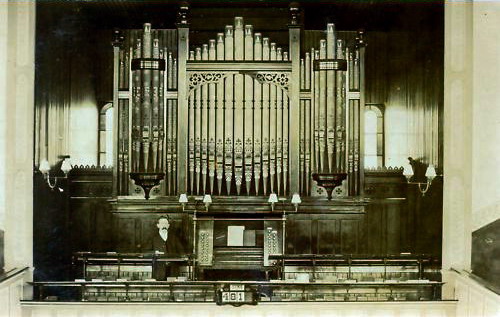
The first meeting of Local Preacher was held in Mr Heald’s house at Waterside, on the 28th September 1808.
George walker who died in 1903 was a local preacher for 43 years. His sermons manifested a loyal attachment to Methodist theology and desire for salvation of souls. The entire circuit sustained a heavy loss by the death of Alfred Livesley, in 1907. for fifty years he rendered valuable service as a preacher of the gospel. Levi Waterhouse was the son of a New Mills publican, who after a ministry of 51 years lies interred in the chapelyard. James Johnson, of Furness Vale, preached his last sermon 53 years after his first. John Willans was an eloquent preacher for 36 years. For half a century Joseph Thornley, who died in 1884, rendered service as a local preacher, his wife Mary survived him for nearly a quarter of a century, at her death she had been a member for 68 years.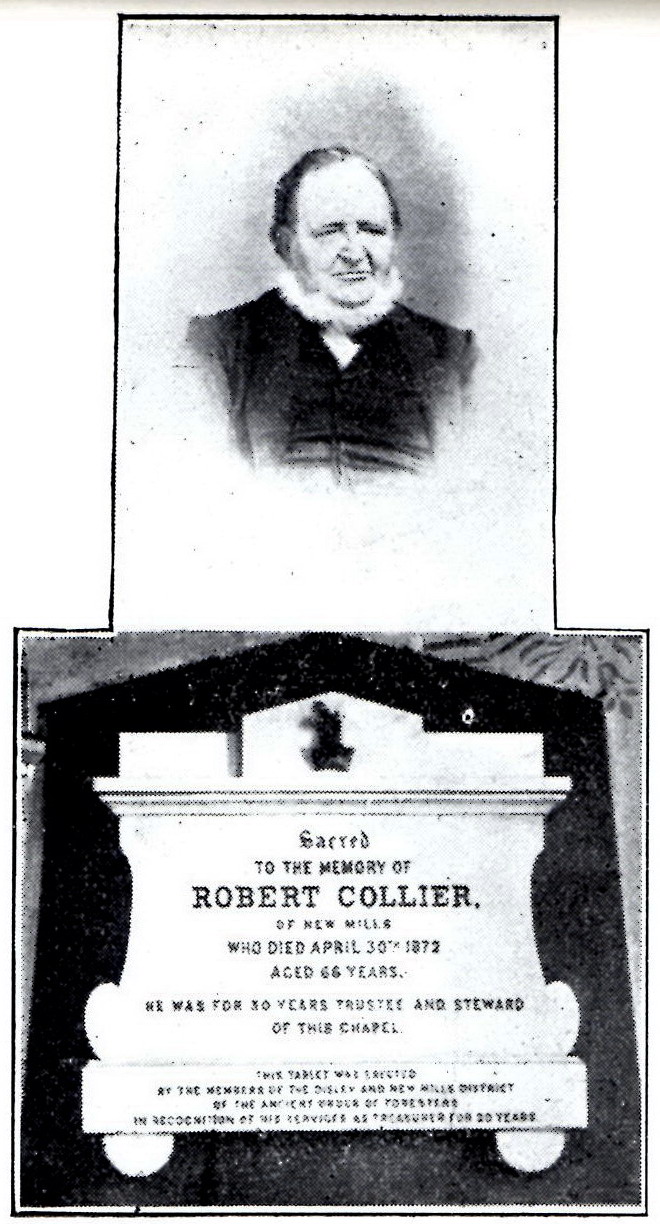
But none played a more prominent part, or did more real service for Wesleyanism than Robert Collier to whose memory there was a handsome tablet within the Chapel. Mr. Collier, who came from an old Methodist yeoman family, was cradled in Wesleyanism and the names of his ancestors are found in the earliest classes. He commenced to preach in 1830, and laboured with great acceptance for 42 years. He also filled the office of Chapel Steward for thirty years. He was a man “in whose heart were the highways of Zion.” He used to conduct an open aired service every Sunday evening when the weather permitted in front of the School room, and filled every Circuit and Society office
THE MINISTERS 1808 to 1911
1808-9 William McKettrick
1809 George Wildon
1809 James Everitt
1810-11 William Midgley
1810 Joseph Chapman
1811 Mark Day
1812 George Beaumont
1813 Jonathan Turner
1813-14 Thomas Preston, Joseph Agar
1815-16 John Hanwell, Thomas Rowland.jpg)
1817 Thomas Pinder, Daniel Walton
1818-19 Mark Davies
1819-20 Samuel Kellett
1820 Michael Coulson
1821 John C. Leppington, Richard Heape
1822-24 Luke Barlow
1822 Daniel Jackson
1823-24 William Davies
1825-26 Thomas Slugg, Robert Bentham
1827-28 Joseph Brookhouse, Alexander Strachan
1828-30 John Strawe
1829-30 George Birley, Richard Felvus
1830 William Vevers
1831-33 William Allen
1831 Joseph Jennings
1832-33 Joseph Jackson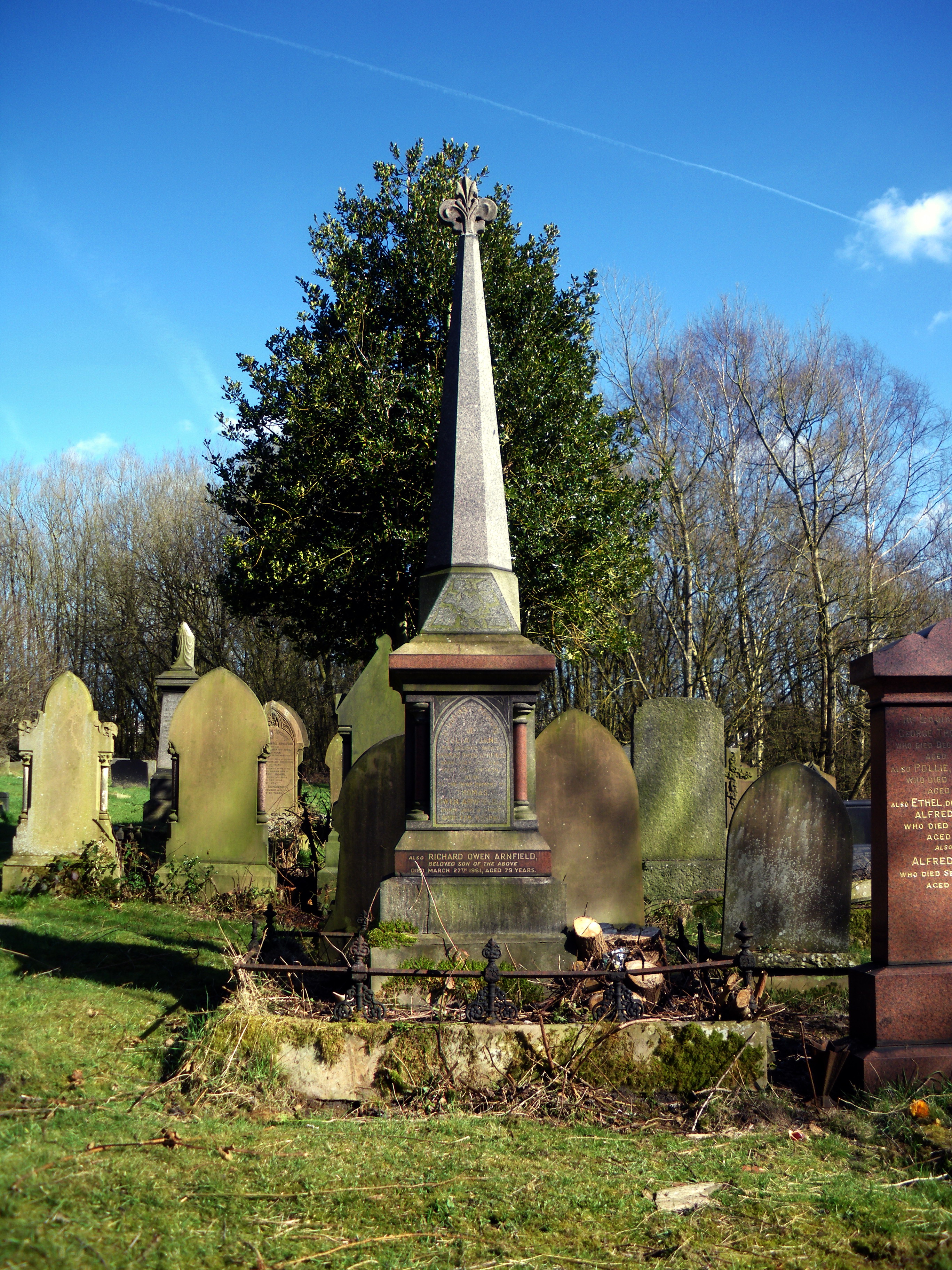
1832 Joseph Brown
1833-34 Thomas Pennington
1834-35 William McKettrick
1835 Charles Taylor
1836 William Waterhouse
1837 John Fairbourne, John Garrett
1838-40 Isaac Denison
1838 William Exley
1839-40 Thomas 0. Keysell
1841-42 Samuel Allen
1841 James Houghton
1812 Charles Howe
1843-45 Thomas I. Baines
1843-44 George Russell
1845 John Hodson
1846-48 Hugh Beech
1846-47 William Hansell
1848-50 Stephen P. Harvard
1849-51 John Connon
1851-53 John W. Crankshaw .jpg)
1852-53 Nathaniel Alston
1854-56 Robert J. T. Hawksley, Henry Cattle
1857 John P. Sumner
1857-59 Thomas Haslam John Boyd
1858-60 John Boyd
1860-62 Henry Beeson
1861-63 George Turner
1863-65 James Wright
1864-66 Joseph R. Cleminson
1866-67 John Priestley
1867 Samuel Rowe
1867-69 Wm. H. Robson, George T. Dixon
1871-73 John M. Budden, Frederick Haines
1874-77 Samuel Smith, John M. Parrett
1877-80 Joseph Midgley
1877 Henry Watts
1878-80 Joseph Howard.jpg)
1880-83 William H. Johnston
1880 Thomas P. Spencer
1881 Joseph Higham
1882-84 Thomas Cross
1883-85 Abel Burgess
1884-87 Ernest S. Thies
1885-88 John Nowell
1887-90 Wm. B. Butters
1888-91 Aaron Edman
1890-93 John E. Howard
1891-94 James Kent
1893-96 Joseph Boulton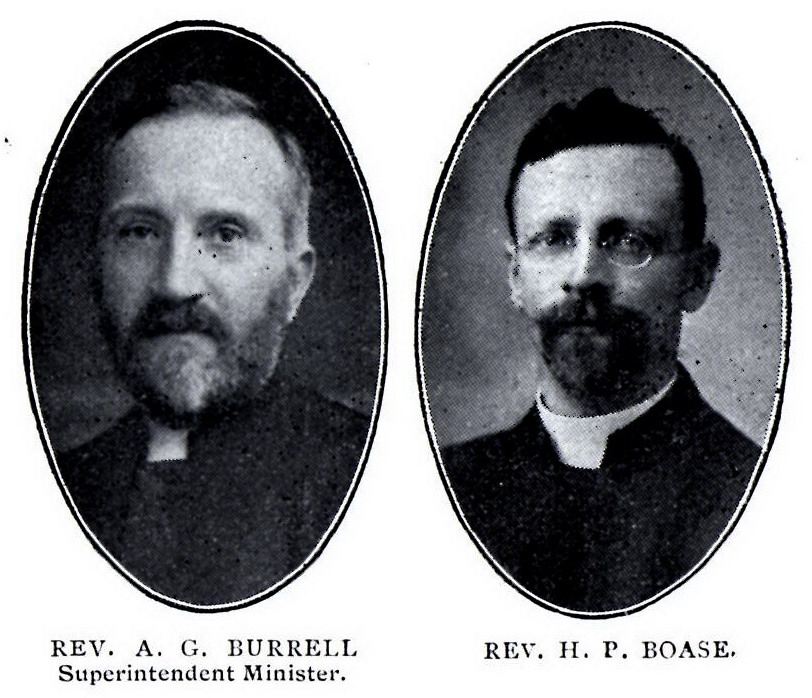
1894-97 Edward Thompson
1896-99 John Bennett
1897-1903 George Scott
1899-1900 Charles Denham
1900-03 R. W. G. Hunter, W. A. Bird
1903-06 Robt. Nicholson, J. S. W. Shrewsbury
1906-10 Wm. H. Coradine
1906-07 Wm. Walton
1907-10 W. C. J. Neville
1910-11 Alfred G. Burrell, H. P. Boase.
CLOSURE
During the 1960’s in common with all Christian churches, there was a slow decline in the congregation of the Chapel. In 1968, a plan was conceived to amalgamate the three Methodist chapels of St. George’s road, Spring Mount and Mount Pleasant as a United Church. The congregations of all three would use Mount Pleasant chapel next to the Town Hall because of its central location. This decision marked the end for the two other chapels and as the cemetery at St. George’s road was to remain open might with hindsight be viewed as a major error of judgement.
.jpg) On Sunday the 21st December 1968, there was a service of carols and thanksgiving for 200 years of Methodist witness in the St. George’s road Chapel. Mr Parry was the preacher. Addressing the large congregation, he told them “Today’s service is not funeral but a christening. The Old Ship is not going to the scrapyard, but is going to be refitted ready for further adventures.” Hymns and carols were accompanied by New Mills Old Prized Band. Special thanksgiving envelopes were distributed one of which was received by Mr Philip Hudson who was married in the Chapel some 50 years before. On Sunday the 21st December 1968, there was a service of carols and thanksgiving for 200 years of Methodist witness in the St. George’s road Chapel. Mr Parry was the preacher. Addressing the large congregation, he told them “Today’s service is not funeral but a christening. The Old Ship is not going to the scrapyard, but is going to be refitted ready for further adventures.” Hymns and carols were accompanied by New Mills Old Prized Band. Special thanksgiving envelopes were distributed one of which was received by Mr Philip Hudson who was married in the Chapel some 50 years before.
After first addressing, the children Mr Parry turned to the congregation. “This,” he told them, “was, apart from the Holy Communion on the 29th of December, the last service the Old Ship would witness. No-one could have attended without a feeling that they had a rendezvous with destiny.” The main purpose of the service was to thank god for all that had been achieved in the history of the Chapel. It had played a great part in the history of the town. At one time, many of the town’s leaders were also worshippers there and the strength of the Sunday School had long been noted as an educational and moral benefit to the town. It was a sad and emotional end to one of the town’s great buildings and institutions.
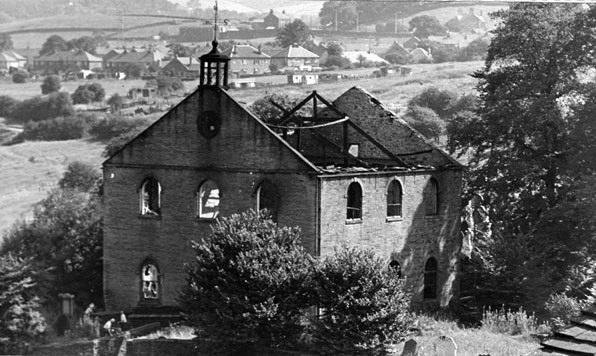
DEMISE
The story of the end of the chapel is sad to relate. How depressing that a building which played so central a role in so many lives, should end its days ruined by the descendents of those who strived so hard to bring it to glory. 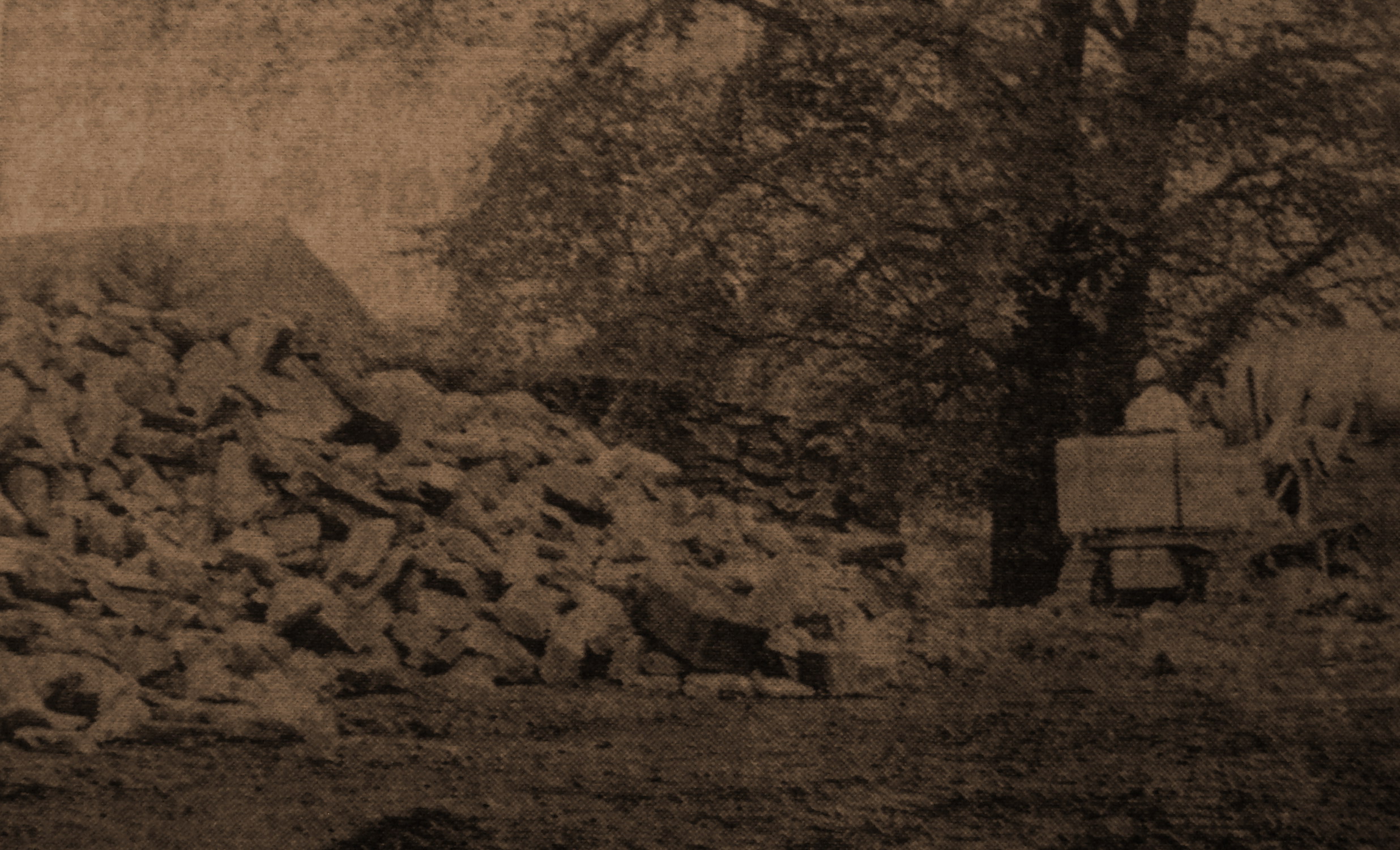
In February 1970, the local paper reported “Since the closure of St. Georges Chapel – the building has been repeatedly attacked by vandals.… there is hardly a window which is not broken. Inside the church, the floor is strewn with torn hymn books and broken glass. A pew is overturned, and the cushioned seat of another lies ripped on the floor. Attempts have been made to board up the windows but have not been effective.
Faced with these problems a decision was taken to demolish the building and sell the 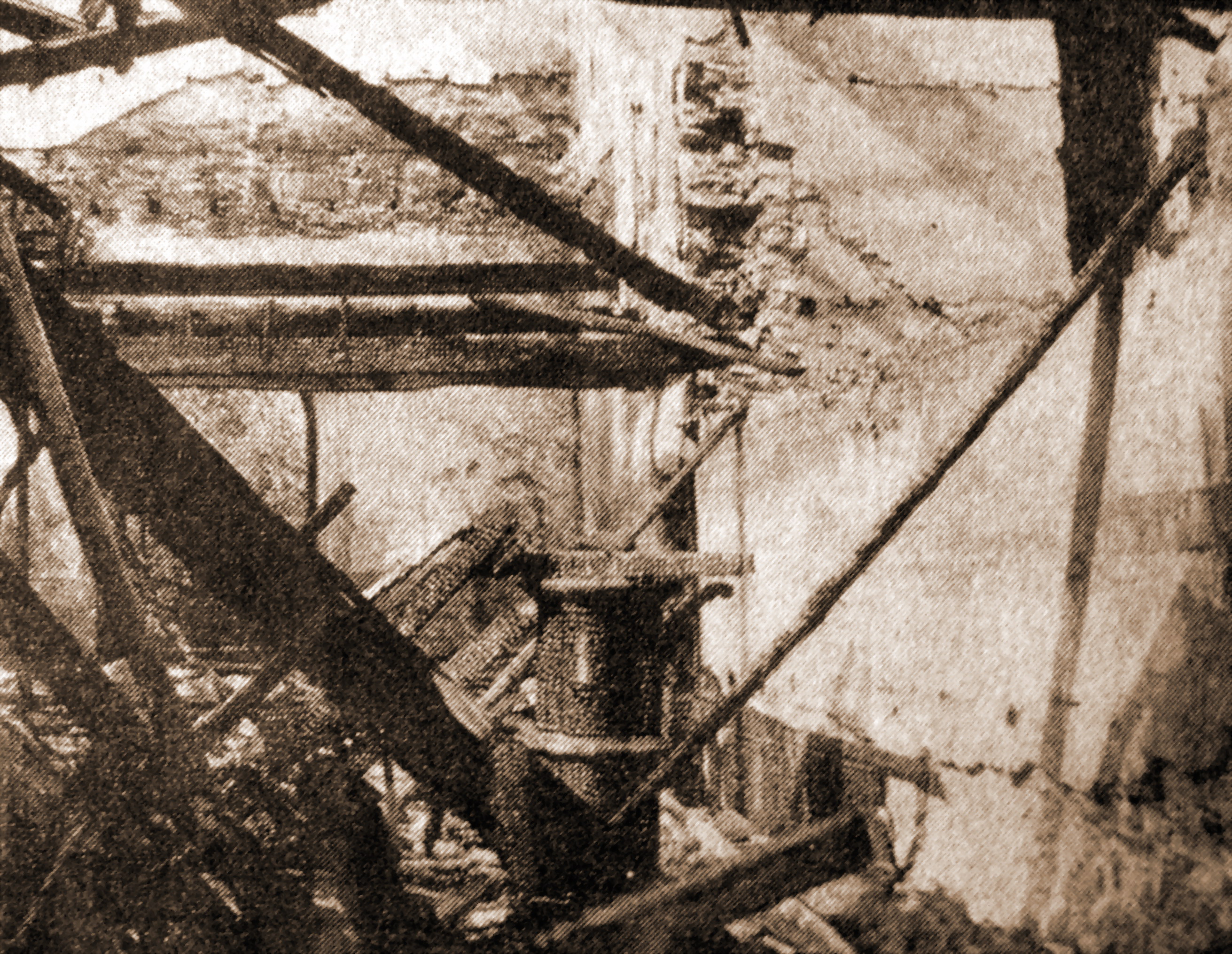 fabric. Work on the demolition started in August 1970. But around a week into the work in the early hours of a Wednesday, morning fire swept through the building destroying all the fixtures and fittings, interior woodwork and roof leaving only the stone shell. The fire brigade, who arrived at 2-12 a.m., could do nothing to save the building. fabric. Work on the demolition started in August 1970. But around a week into the work in the early hours of a Wednesday, morning fire swept through the building destroying all the fixtures and fittings, interior woodwork and roof leaving only the stone shell. The fire brigade, who arrived at 2-12 a.m., could do nothing to save the building.
Demolition work re-commenced in October and every trace of the chapel was removed from the site.
Today the “twenty four steps to Salvation” lead to an area of ivy and scrub in the cemetery where once the chapel stood. Recent works have opened up the cemetery and revealed some of the history it contains.

Church/Chapel Attendances, 1851 in New Mills:
Morning Evening
Anglican 150 250
Methodist 721 467
Roman Catholic 241 123
Sources - New Mills Wesleyanism and others.
 |







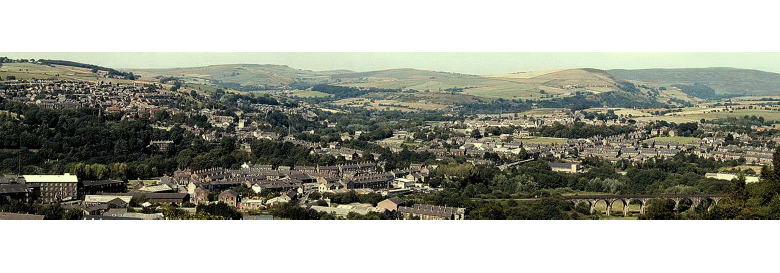


.jpg) The Healds were big folk at Waterside more than a century back, and they secured the land on which the present Chapel and Preacher's house were to be built, from Randle Taylor, the owner of the estate right away to Low Leighton, who had lived close to where the Chapel now is, but who had removed to Wormhill, near Tideswell, and thus it was that the land was leased by Mr. James Heald. It was part of the " Great Mill Field," and was let on a perpetual rent of £10 10s. 8d. per year. But this was only the plot on which the Chapel and house stand, in fact Randle Taylor's house stood close by, and his garden was afterwards acquired for burial-ground purposes. The chapel and house having been built, the property was, on the 6th of August, 1810, the jubilee year of the reign of King George the Third, properly conveyed by agreement ''between James Heald, of Waterside, within Disley, in the county of Chester calico printer, of the first part; George Heald, of Waterside, calico printer, of the second part; and William Wright, of Strines, calico printer; James Wild, of New Mill, shopkeeper, John Barnes, of New Mill, spinner: John Hill, of the same place, gentleman; Edward Waine, of Marple, muslin manufacturer; Richard Bennett, of New Mill, shoemaker; Abraham Whittaker, dealer in cotton ; Robert Thatcher, tailor; John Rusby, cotton spinner ; Jacob Fell, cotton spinner ; Thomas Moult, of Bongs, gentleman ; Samuel Gosling, of Bullock Smithy, manufacturer ; and Samuel Bennett, of Manchester, joiner, These were the first trustees of the new Chapel.
The Healds were big folk at Waterside more than a century back, and they secured the land on which the present Chapel and Preacher's house were to be built, from Randle Taylor, the owner of the estate right away to Low Leighton, who had lived close to where the Chapel now is, but who had removed to Wormhill, near Tideswell, and thus it was that the land was leased by Mr. James Heald. It was part of the " Great Mill Field," and was let on a perpetual rent of £10 10s. 8d. per year. But this was only the plot on which the Chapel and house stand, in fact Randle Taylor's house stood close by, and his garden was afterwards acquired for burial-ground purposes. The chapel and house having been built, the property was, on the 6th of August, 1810, the jubilee year of the reign of King George the Third, properly conveyed by agreement ''between James Heald, of Waterside, within Disley, in the county of Chester calico printer, of the first part; George Heald, of Waterside, calico printer, of the second part; and William Wright, of Strines, calico printer; James Wild, of New Mill, shopkeeper, John Barnes, of New Mill, spinner: John Hill, of the same place, gentleman; Edward Waine, of Marple, muslin manufacturer; Richard Bennett, of New Mill, shoemaker; Abraham Whittaker, dealer in cotton ; Robert Thatcher, tailor; John Rusby, cotton spinner ; Jacob Fell, cotton spinner ; Thomas Moult, of Bongs, gentleman ; Samuel Gosling, of Bullock Smithy, manufacturer ; and Samuel Bennett, of Manchester, joiner, These were the first trustees of the new Chapel. William McKitrick and James Everett were the ministers when the Chapel was built. They were two of the most notable men that Methodism ever produced. McKitrick was a most remarkable man. He was an Irishman, converted when 19 years of age, and had to flee from home on account of his religion. He stood many a storm and in 1812 after leaving New Mills, he was taken prisoner near Bolton for preaching. James Everett's name in known the world over. He was an author of considerable repute, and wrote the history of Methodism in the Manchester and Sheffield districts.
William McKitrick and James Everett were the ministers when the Chapel was built. They were two of the most notable men that Methodism ever produced. McKitrick was a most remarkable man. He was an Irishman, converted when 19 years of age, and had to flee from home on account of his religion. He stood many a storm and in 1812 after leaving New Mills, he was taken prisoner near Bolton for preaching. James Everett's name in known the world over. He was an author of considerable repute, and wrote the history of Methodism in the Manchester and Sheffield districts..jpg) It was in 1856, that the scheme was fairly taken in hand. Many men and women made donations and a Bazaar, the first held in the district raised enough to liquidate the debt.
It was in 1856, that the scheme was fairly taken in hand. Many men and women made donations and a Bazaar, the first held in the district raised enough to liquidate the debt.

.jpg)

.jpg)
.jpg)

.jpg) On Sunday the 21st December 1968, there was a service of carols and thanksgiving for 200 years of Methodist witness in the St. George’s road Chapel. Mr Parry was the preacher. Addressing the large congregation, he told them “Today’s service is not funeral but a christening. The Old Ship is not going to the scrapyard, but is going to be refitted ready for further adventures.” Hymns and carols were accompanied by New Mills Old Prized Band. Special thanksgiving envelopes were distributed one of which was received by Mr Philip Hudson who was married in the Chapel some 50 years before.
On Sunday the 21st December 1968, there was a service of carols and thanksgiving for 200 years of Methodist witness in the St. George’s road Chapel. Mr Parry was the preacher. Addressing the large congregation, he told them “Today’s service is not funeral but a christening. The Old Ship is not going to the scrapyard, but is going to be refitted ready for further adventures.” Hymns and carols were accompanied by New Mills Old Prized Band. Special thanksgiving envelopes were distributed one of which was received by Mr Philip Hudson who was married in the Chapel some 50 years before.

 fabric. Work on the demolition started in August 1970. But around a week into the work in the early hours of a Wednesday, morning fire swept through the building destroying all the fixtures and fittings, interior woodwork and roof leaving only the stone shell. The fire brigade, who arrived at 2-12 a.m., could do nothing to save the building.
fabric. Work on the demolition started in August 1970. But around a week into the work in the early hours of a Wednesday, morning fire swept through the building destroying all the fixtures and fittings, interior woodwork and roof leaving only the stone shell. The fire brigade, who arrived at 2-12 a.m., could do nothing to save the building. 